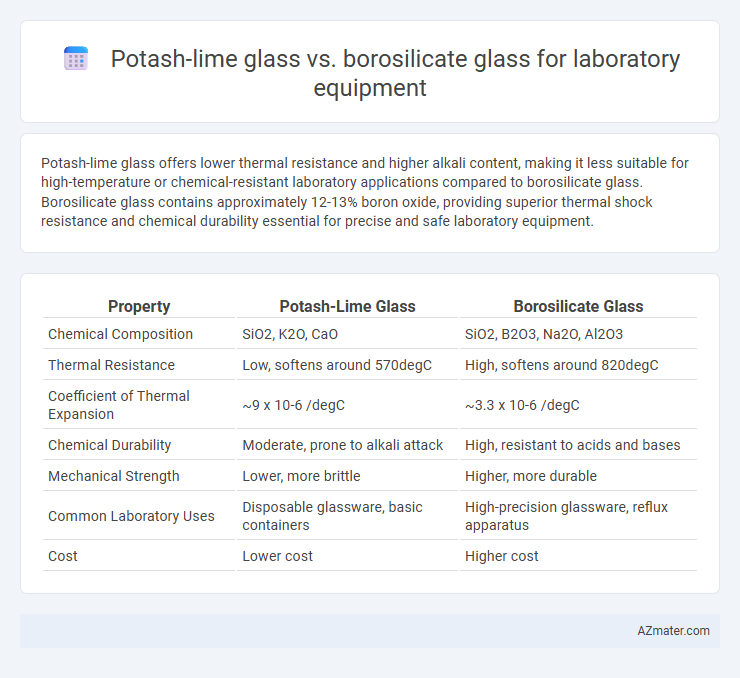Potash-lime glass offers lower thermal resistance and higher alkali content, making it less suitable for high-temperature or chemical-resistant laboratory applications compared to borosilicate glass. Borosilicate glass contains approximately 12-13% boron oxide, providing superior thermal shock resistance and chemical durability essential for precise and safe laboratory equipment.
Table of Comparison
| Property | Potash-Lime Glass | Borosilicate Glass |
|---|---|---|
| Chemical Composition | SiO2, K2O, CaO | SiO2, B2O3, Na2O, Al2O3 |
| Thermal Resistance | Low, softens around 570degC | High, softens around 820degC |
| Coefficient of Thermal Expansion | ~9 x 10-6 /degC | ~3.3 x 10-6 /degC |
| Chemical Durability | Moderate, prone to alkali attack | High, resistant to acids and bases |
| Mechanical Strength | Lower, more brittle | Higher, more durable |
| Common Laboratory Uses | Disposable glassware, basic containers | High-precision glassware, reflux apparatus |
| Cost | Lower cost | Higher cost |
Introduction to Laboratory Glass Types
Potash-lime glass and borosilicate glass are primary materials used in laboratory equipment, with each offering distinct chemical and thermal properties. Potash-lime glass is more affordable and commonly used for general purpose labware, but it has lower resistance to thermal shock and chemical corrosion compared to borosilicate glass. Borosilicate glass, containing silica and boron trioxide, provides superior durability and thermal stability, making it ideal for precise scientific experiments and applications involving rapid temperature changes.
Composition of Potash-lime Glass
Potash-lime glass primarily consists of silica (SiO2), potassium oxide (K2O), and calcium oxide (CaO), forming a network that offers moderate chemical durability and thermal resistance suitable for basic laboratory applications. The higher potassium oxide content compared to soda-lime glass enhances its thermal expansion properties, making it less resistant to sudden temperature changes than borosilicate glass, which contains significant boron oxide (B2O3) for improved thermal shock resistance. Due to its compositional differences, potash-lime glass is more prone to chemical corrosion and thermal stress, limiting its use in demanding experimental conditions where borosilicate glass excels.
Composition of Borosilicate Glass
Borosilicate glass, primarily composed of silica (SiO2) and boron trioxide (B2O3), exhibits superior thermal resistance and chemical durability compared to potash-lime glass, which contains higher amounts of sodium and calcium oxides. The addition of boron trioxide in borosilicate glass lowers its coefficient of thermal expansion, making it ideal for laboratory equipment subjected to rapid temperature changes. This composition enhances resistance to thermal shock and chemical corrosion, ensuring reliability and longevity in lab applications.
Thermal Properties Comparison
Potash-lime glass exhibits lower thermal resistance with a coefficient of thermal expansion around 8.5 x 10^-6 /degC, making it more prone to cracking under rapid temperature changes compared to borosilicate glass, which has a much lower expansion coefficient near 3.3 x 10^-6 /degC. Borosilicate glass can withstand thermal shock up to approximately 165degC, whereas potash-lime glass tolerates significantly less, often limiting its use in high-heat laboratory applications. This superior thermal stability of borosilicate glass ensures safer handling of sudden temperature fluctuations in scientific experiments.
Chemical Resistance and Durability
Borosilicate glass offers superior chemical resistance compared to potash-lime glass, making it highly suitable for handling aggressive acids and alkalis in laboratory settings. Its low thermal expansion coefficient enhances durability under rapid temperature changes, reducing the risk of thermal shock and breakage. Potash-lime glass, while more affordable, exhibits lower chemical resistance and is more prone to cracking under thermal stress, limiting its use for demanding laboratory applications.
Mechanical Strength and Fragility
Potash-lime glass exhibits lower mechanical strength compared to borosilicate glass, making it more prone to breakage under stress or sudden temperature changes. Borosilicate glass is engineered with a higher resistance to thermal shock and mechanical impact, offering superior durability and longevity in laboratory environments. Laboratories requiring frequent heating and cooling cycles prefer borosilicate glass due to its reduced fragility and enhanced ability to withstand mechanical stress.
Cost and Availability
Potash-lime glass is significantly more cost-effective than borosilicate glass, making it a preferred choice for general laboratory equipment with budget constraints. It is widely available due to its common use in everyday glass products, ensuring easy sourcing and replacement. Borosilicate glass, while more expensive, offers superior thermal resistance and chemical durability but has limited availability compared to potash-lime glass in standard lab supply outlets.
Suitability for Laboratory Applications
Potash-lime glass is less resistant to thermal shock and chemical corrosion, making it suitable primarily for general laboratory glassware used in routine applications with moderate temperature variations and non-aggressive chemicals. Borosilicate glass offers superior thermal resistance, durability, and chemical inertness, making it ideal for high-precision laboratory equipment, including condensers, flasks, and pipettes exposed to rapid temperature changes and corrosive substances. Its low coefficient of thermal expansion minimizes breakage, ensuring reliability in demanding experimental environments.
Common Laboratory Equipment Made from Each Glass
Potash-lime glass is commonly used in test tubes, culture tubes, and disposable petri dishes due to its affordability and chemical resistance to neutral substances. Borosilicate glass, known for superior thermal and chemical resistance, is preferred for beakers, flasks, and condensers in laboratory settings requiring high-temperature durability. The selection between potash-lime and borosilicate glass hinges on the specific laboratory application, balancing cost efficiency with performance under thermal stress.
Choosing the Right Glass for Laboratory Use
Potash-lime glass offers affordability and good chemical resistance suitable for general laboratory equipment, but borosilicate glass excels with superior thermal shock resistance and durability for high-temperature or corrosive experiments. Borosilicate glass's low coefficient of thermal expansion minimizes fracture risk during rapid temperature changes, making it ideal for precise scientific applications. Selecting between potash-lime and borosilicate glass hinges on specific lab requirements, balancing cost against performance and safety standards.

Infographic: Potash-lime glass vs Borosilicate glass for Laboratory equipment
 azmater.com
azmater.com